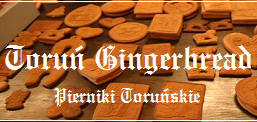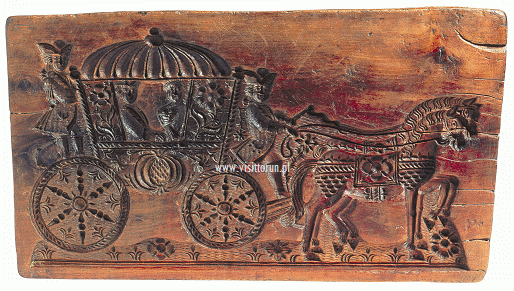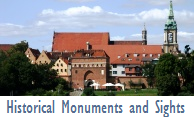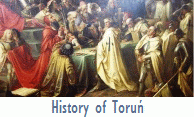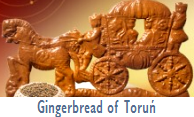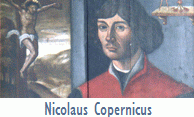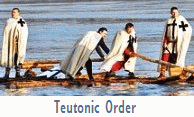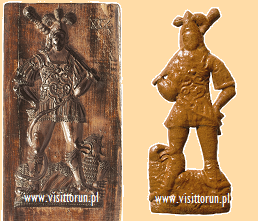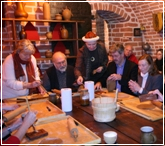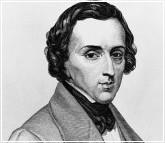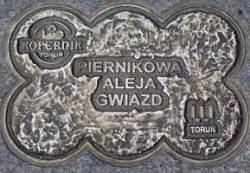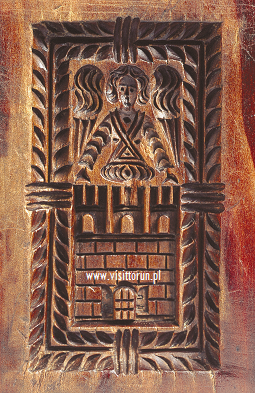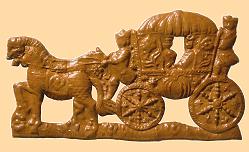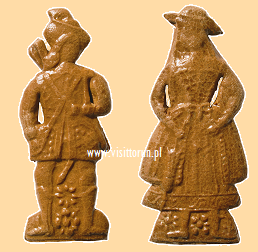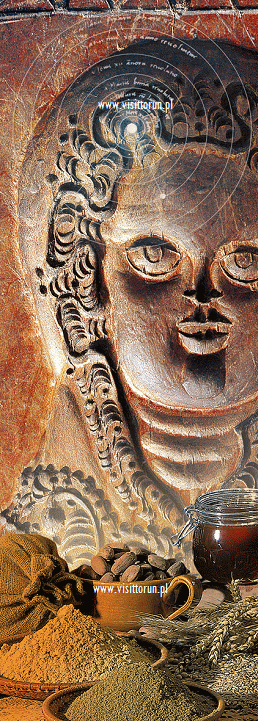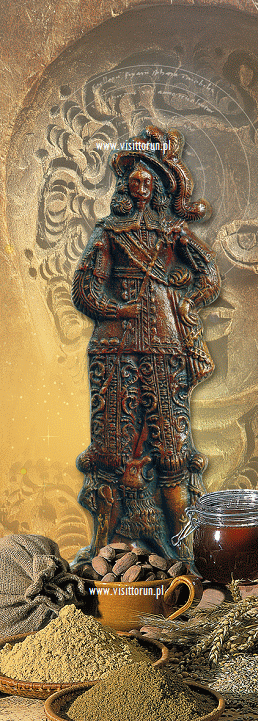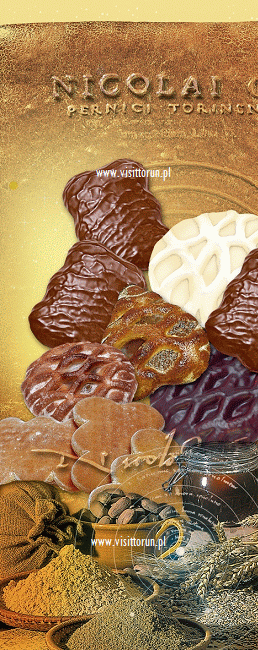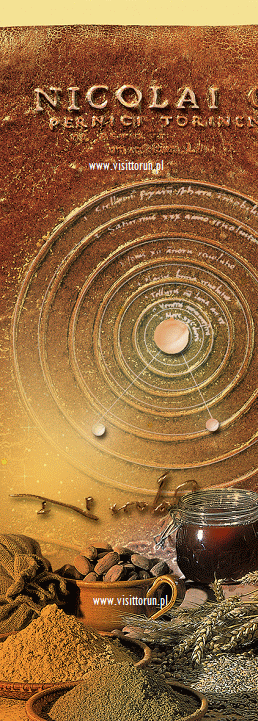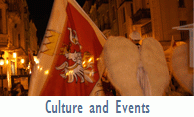|
Toruń gingerbread (Polish: Pierniki toruńskie), instantly recognizable as part of Toruń heritage, tradition and legend, is undoubtedly the city’s trademark and pride. Its peculiarity and uniqueness lies in its unusual taste, outstanding quality and sophisticated artistic form.
| |
|
|
|
The first references to the gingerbread manufacturing in Toruń date from 1380 and are associated with Niclos Czan, one of Toruń bakers of the period. However, the first gingerbread cakes in Toruń were baked as early as the 13th century.
They were first made by ordinary bakers, sometimes referred to as pastry cooks, who eventually came to be termed gingerbread cooks. Similar cakes were made also by nuns in the local convents. As early
|
|
Make a famous Toruń gingerbread
on your own!
Visit the 'World of Torun Gingerbread' exhibition with our guides, who dressed in period attires will introduce you to the world of Torun gingerbread by showing you around the exhibition, telling interesting stories, and baking ornamental gingerbread. Especially for you we have prepared the replicas of historic gingerbread baking trays. Not only will you visit the exhibition, but also you will have the chance to bake your own gingerbread, and taste the ones produced by Fabryka Cukiernicza “Kopernik” S.A. (the Confectionery Factory). We would also like to invite you for evening gingerbread feasts, which can be accompanied with the sound and light show at the model of Torun, or the theatre performance.
|
| |
|
|
as the 14th century an anonymous Latin poem was written in praise of the gingerbread, entitled "On spicy bread i.e Toruń gingerbread". It extolled the merits of the cakes emphasizing their excellent taste, especially when tried with liquor.
The very word 'Piernik' in Polish (“gingerbread”) originates from the old Polish term describing spice known as “pierna”, added to flour and honey to make gingerbread batter. The spice arrived in Europe with the crusades, which initiated trade development between Europe and the Middle East.
Toruń gingerbread recipes differed from baker to baker. All of them were well-guarded secrets and the recipe exchange between bakers was limited. In 1556 Toruń and Nuremberg entered into an agreement allowing the free use of Nuremberg recipes by Toruń bakers and, in return, granting the former the right to bake cakes according to Toruń recipes. In 1884 Kujot wrote: "...just
|
|
Frederic Chopin (>>) was one of the gingerbread lovers. Following his visit to Toruń in 1825, he wrote to his friend in a letter: "...gingerbread has made the greatest impression, or effect, on me. Surely, I have seen the whole city fortification, too (...), I saw the famous machine to move sand from one place to another (...), and the Gothic churches (...). I saw the leaning tower, the famous City Hall (...). All this, however, cannot compare to the gingerbread, yes, the gingerbread, one of which I sent to Warsaw…". In memory of the visit, a special type of gingerbread is produced nowadays, called "Scherzo".
|
| |
|
|
as Nuremberg in the whole of Germany, so Toruń managed to secure the precedence of its own produce in Poland. Recognizing their own fame, both cities guarded their gingerbread secrets with jealousy and were well-aware of their own right to monopoly,
keeping their spicing methods to themselves...".
Toruń bakers kept the recipes secret not only from Nuremberg or Königsberg “competitors” – the latter attempting to reproduce the taste of Toruń gingerbread – but from other Toruń bakers as well. Just as was the case with wines produced in the best French or Italian vineries: one needed only to try gingerbread to instantly recognize which Toruń bakery it came from, judging by its elaborate taste.
The present-day gingerbread manufacturing methods are based on the old recipes and technologies going back to the 16th-century
|
|
Gingerbread Walk of Fame
On the pavement outside the Arthus House, there is the Gingerbread Walk of Fame (Polish: Piernikowa Aleja Gwiazd), initiated in 2003. The pavement plaques, shaped like the gingerbread "katarzynka", feature the autographs of the famous people who were either born in Torun or are associated with the city.
|
| |
|
|
tradition of gingerbread baking. Toruń gingerbread is made of the highest quality flour and honey, which owe their unique taste to the forests and fields located along the Vistula river, as well as the oriental spices. From time immemorial beautiful, old Hanseatic Toruń was located at the intersection of the most important European trade routes, which facilitated importing spices determining the excellent gingerbread taste from the Middle East. These included ginger, clove, cinnamon, cardamom, nutmeg, etc., which explains why the superbly tasting gingerbread was born precisely here.
The development of Toruń gingerbread manufacturing reached its apogee in the 17th and 18th centuries, since when Toruń has begun to be largely recognized for its gingerbread within Europe. Because of their durability, the cakes accompanied merchants on long-distance trips, even war expeditions; no significant visitor was allowed out of the city without them. The gingerbread served also medical purposes, yet most commonly it was used as an after-dinner snack or it accompanied wines, meads or vodka. |
|
|
|
Figural gingerbread
Just like any other commodity, Toruń gingerbread had and continues to have competitors. However, it far surpasses the competition with its beautiful forms. Woodcarvers and bakers laid much significance on gingerbread appearance and developed gingerbread making into a new form of art. They baked the cakes in different shapes and sizes in ornamental wooden or clay baking trays, which in themselves were considered beautiful and were frequently used as gifts. They were real works of art, made with great precision and rich in details. The bakers did not limit themselves to simple shapes and patterns, but strived to produce some more sophisticated forms.
The most common gingerbread motifs included Kings and Queens of Poland, angels, Mother and Child, the manger, St. George fighting with a dragon, soldiers of the Swedish war period, Adam and Eve in the Garden of Eden, a variety of genre scenes, animals, or the famous ornamental horse-drawn carriage. The artistry of the wooden baking tray making is particularly outstanding. Today they constitute woodcarving masterpieces, available for viewing on permanent exhibition of Toruń craft in the Old City Town Hall. The art of gingerbread tray making began to disappear in the 19th century with the development of technology. The oldest surviving forms date from the early 17th century. Before World War II, there were over 700 such forms, yet their number dwindled to half during war.
The point of baking gingerbread was additionally to honour important people. Polish King Ladislas IV Vasa is remembered for a gingerbread medallion. Its surviving form suggests it was 24 cm in diameter and its main elements included a crown and the White Eagle with Vasa coat of arms held by two angels. Pope John Paul II was presented by Toruń Gingerbread Bakers delegation with an occasional cake shaped like the Heliocentric System as visualized on Nicolaus Copernicus’ work "De Revolutionibus, etc."
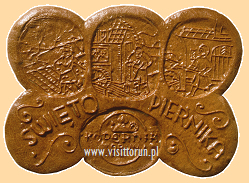
However, the most recognizable and typical gingerbread shape is the simple “Catherine” (Polish: "katarzynka"), made by joining six circles (medallions) together. Today it is mass produced on the assembly line in chocolate coating or plain. History remains silent as to who devised the cake of this shape and where the name derives from. There are, however, several beautiful legends explaining the origins of the “Catherine” cake. One of them has it that the author of the peculiar gingerbread shape and name was a young and modest apprentice who was in love with beautiful Catherine – his master’s daughter. Intent on winning her heart, he designed the cake to make an impression on Catherine and her father.
A well-known 17th century Polish saying lists Gdańsk vodka, Toruń gingerbread, Krakow maiden and Warsaw ankle boot among the best Polish things of that time. The city earned the distinction due to the hard work and artistry of gingerbread bakers, their fame spreading far abroad.
The city authorities were well aware of the advantages of baking gingerbread and thus they granted the bakers numerous privileges such as, for example, excise tax exemption for spices or no export tax on gingerbread. They took a good care of marketing the cakes and maintaining the city’s good reputation, sending gingerbread to all those whose favours they sought. By way of illustration, gingerbread cakes and a bottle of cinnamon vodka, believed to have “mood-enhancing properties”, were sent to the Vatican with Bishop Henryk Firlej as a gift from Benedictine abbess.
Gingerbread also helped to bribe Swedish dignitaries into accelerating debt repayment by the Swedish for all unpaid commodities labour and damage Toruń suffered under Swedish occupation in 1658.
In 1663, in a letter sent to Toruń, Jan Graf expressed his regret for not being able to take Hungarian wine and Toruń gingerbead to enforce due payment from the Swedish, as restricted by the Peace Treaty of Oliwa.
In 1696 the city offered the cakes to Swedish Count Gyllenberg to negotiate lenient debt repayment terms in favour of the city.
Well-known in history is Toruń’s gift to Tsarina Catherina in 1778, which took the form of an approximately 2-metre-long and about 30-cm thick gingerbread cake. The gift, worth 300 rix-dollars, was decorated with Toruń coat of arms on top and framed by a two-headed Russian eagle and two one-headed eagles.
After the city passed under the Prussians rule in 1793, gingerbread cakes started to bear Tadeusz Kościuszko image as the manifestation of patriotism and Toruń craftsmen’s affinity for the insurrection leader.
The first gingerbread factory was established by Jan Weese in 1763 at 4 Strumykowa Street. Today its heir and continuator is Confectionary Factory "Kopernik". In 1862 there were as many as 5 operating factories, including Hermann Thomas Company of 1857.
Toruń gingerbread is associated with a number of legends.
Toruń gingerbread legends
Legends associated with Toruń gingerbread – the most famous and typical Toruń product, are not as old as the very tradition of baking it. However, they come in large numbers and are vividly colourful. Above all, they well describe the source of Toruń fame. Nearly 700-year-old gingerbread tradition gave rise to a large number of mysterious tales by virtue of the unique spicy taste and fanciful gingerbread shapes. The development of the legends was at its best only in the 19th century; alongside the increase in the fairy tale writing, especially in the Grimm brothers literary activities, there appeared a more favourable atmosphere for inventing the legends.
|
|
|
Where to buy the Toruń gingerbread?
Everyone can easily find gingerbread in Toruń. You can buy the Toruń gingerbread in almost every grocery shop in the city.
However within the Old Quarter there are the shops specialized only in gingerbread, among others, in the Old City Market Square, in Żeglarska Street, or Piekary Street.
...........................................................................................................................................................................
| Users' comments (14) | | 1/5 | choose sub-page: 1 2 3 4 5 from 5 |
| Carolhjeske@gmail.co, 2025-06-30 18:19:19 (173.169.2.106)
For molds check out House on the Hill cookie molds in the US
| Air France Cancellat, 2025-05-20 09:44:05 (122.162.150.207)
Air France Cancellation Policy
| fikadax, 2025-01-09 16:30:12 (154.47.23.111)
Hi. I wonder if there is some on-line shops which we can buy the cookie molds, I live in Sweden.
Many thanks,
| | 1/5 | choose sub-page: 1 2 3 4 5 from 5 |
|
|
|
Curent local weather in Toruń  | temp. 7.3° C |
|
